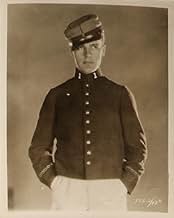Ajouter une intrigue dans votre langueMichael "Beau" Geste leaves England in disgrace and joins the infamous French Foreign Legion. He is reunited with his two brothers in North Africa, where they face greater danger from their ... Tout lireMichael "Beau" Geste leaves England in disgrace and joins the infamous French Foreign Legion. He is reunited with his two brothers in North Africa, where they face greater danger from their own sadistic commander than from the rebellious Arabs.Michael "Beau" Geste leaves England in disgrace and joins the infamous French Foreign Legion. He is reunited with his two brothers in North Africa, where they face greater danger from their own sadistic commander than from the rebellious Arabs.
- Réalisation
- Scénario
- Casting principal
- Récompenses
- 5 victoires au total
- Prince Ram Singh
- (as Ram Singh)
Avis à la une
With only minor variations the story from the 1939 version is what you see here so if you've seen that you know what to expect. The Geste boys are all suspected of stealing a precious family jewel and all enlist in the Foreign Legion to cover up the disgrace of the one they think might have stolen the gem.
Once there the brothers fall afoul of the sadistic Sergeant Lejaune played by perennial villain Noah Beery. William Powell who was one of Ronald Colman's best friends in Hollywood plays the sneak informer Boldini who learns of the purloined jewel and inflames Beery with the tale. Powell who also had impeccable diction was playing mostly villains due to his swarthy complexion. His career like Colman's was enhanced when talkies came in.
The film is every bit as exciting as when it was first released in 1926 and holds up very well for today's audiences. All it lacks are the great speaking voices of Colman and Powell.
Now, I'm not a fan of sweeping epics. I, for one, hate David Lean's work with a passion. But in the silent days, many a great epic film was made, and this in one of them.
Probably the most incredible thing is the sheer size of this movie. The opening scenes of the french troops advancing toward the fort, or later with the arabs doing the same thing, are astounding. Unlike in Lean's work, where crowds of chattering background players rush about in every direction, director Herbert Brennon skillfully weaves his literal army of extras over the sand dunes, obviously going to great lengths to ensure that he gets a breathtaking shot. And cinematographer Roy Hunt captures it impeccably, only as an artist would. I'd like to see more of his.
I saw this movie last night in a restored silent movie theater with live organ accompaniment. The organist, the incredible Dennis James, mentioned that some audience members might feel that they had seen this film before, only that they thought that it was with Gar Cooper. I haven't seen that version, but apparently it's almost a shot-for-shot remake. I'd love to see it if it's even half as good as this one.
The plot revolves around three brothers, their love for each other, and a missing family jewel called "The Blue Water." The jewel is taken at the beginning of the movie, and Colman's character, the eldest Geste brother, Michael (Beau), is believed to be the culprit. The mystery of who took the priceless jewel and why, is solved as the story slowly unfolds with each brother joining the French Foreign Legion.
The desert shooting in this film is supposed to be some of the best ever photographed and the director, Herbert Brenon manages the Legionaries and Arabs treks across the desert splendidly! A fine cast with Neil Hamilton (Digby Geste), Ralph Forbes (John Geste), Alice Joyce (Lady Patricia Brandon), Noah Berry (Sgt. Lejaune), and William Powell (Boldini) go all out! This film is silent film making at it's best and rarely misses a beat! It will keep your attention from start to finish and is one of those films that must be watched closely in order not to miss out on the plot development and fine nuances of the characters.
I haven't yet viewed the remake with Gary Cooper, but it apparently follows almost verbatim with the original, which is the greatest of compliments!
None of the characters have quite enough time to become quite endearing as individuals, but the mysteriousness of the opener makes the film enjoyable to watch. However, audiences are greeted with many familiar and competent actors. Don't worry though; the ending is very satisfying.
Le saviez-vous
- AnecdotesContrary to reference books on the subject, the film did not have Technicolor inserts according to Technicolor's records. Some Technicolor footage was indeed photographed for the production, but not used in the final print.
- Citations
Lady Patricia Brandon: If the sapphire is not returned by morning, I shall be more sorry than I can say - to know that one of you is a common thief!
- Versions alternativesThe running time of Beau Geste (1926) upon initial release was 129 minutes. It was subsequently cut to shorter lengths twice for re-releases. Under the supervision of The Library of Congress, the movie was restored to its original length. The restored version screened at the Museum of Modern Art on August 1, 2025.
- ConnexionsFeatured in The House That Shadows Built (1931)
Meilleurs choix
- How long is Beau Geste?Alimenté par Alexa
Détails
Box-office
- Montant brut aux États-Unis et au Canada
- 1 708 926 $US
- Durée
- 1h 41min(101 min)
- Couleur
- Mixage
- Rapport de forme
- 1.33 : 1





































